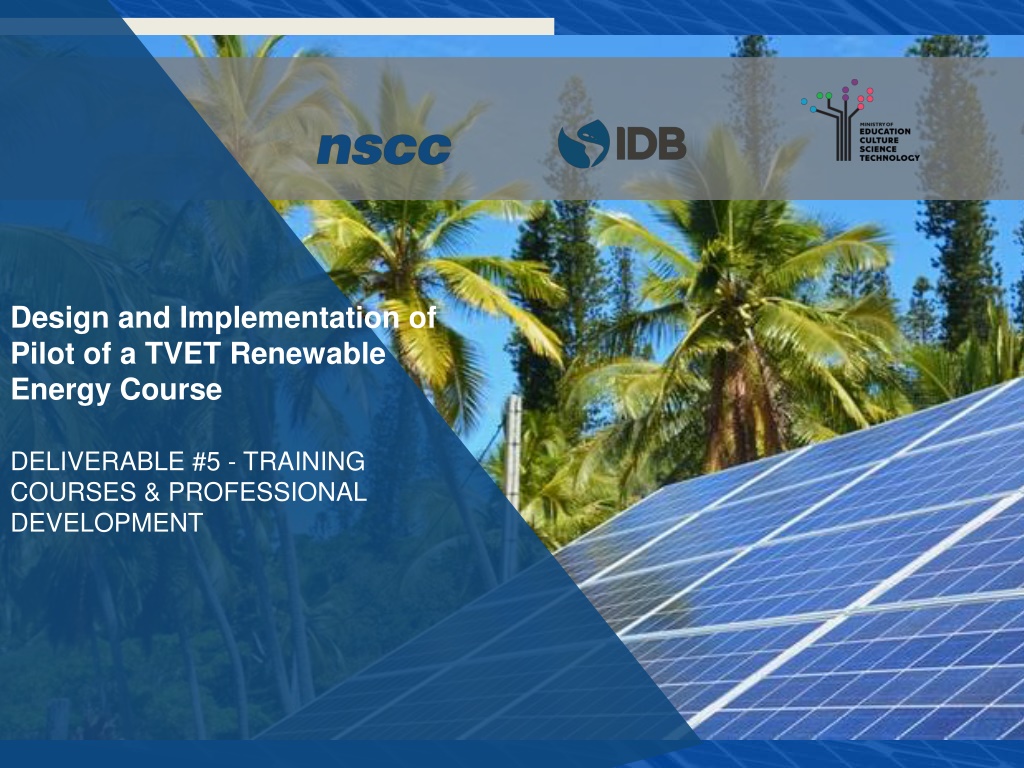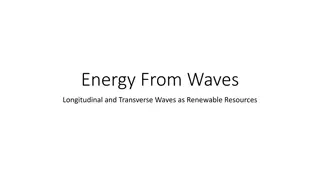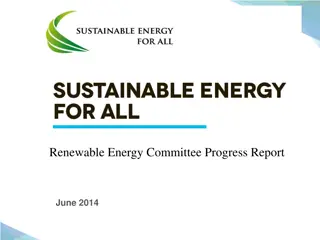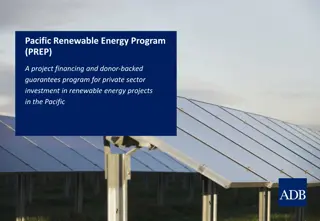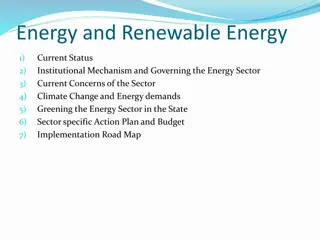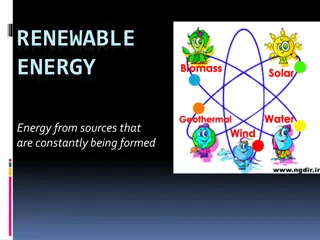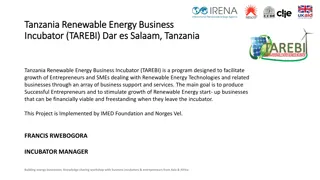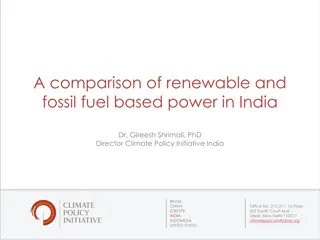Mastering Synchronizing of AC Power Generating Equipment in Renewable Energy Training Course
This module focuses on educating learners about the synchronization process of AC power producing equipment, including the differences between synchronous and induction generators, calculating generator frequencies, and understanding the operation of synchroscopes and the three light bulb method for synchronization. It also delves into defining AC power producing equipment like generators and alternators, providing insights into their functions and applications. By the end of this training, participants will have a comprehensive understanding of synchronizing power sources, aiding their professional development in the renewable energy sector.
Download Presentation

Please find below an Image/Link to download the presentation.
The content on the website is provided AS IS for your information and personal use only. It may not be sold, licensed, or shared on other websites without obtaining consent from the author. Download presentation by click this link. If you encounter any issues during the download, it is possible that the publisher has removed the file from their server.
E N D
Presentation Transcript
Design and Implementation of Pilot of a TVET Renewable Energy Course DELIVERABLE #5 - TRAINING COURSES & PROFESSIONAL DEVELOPMENT
Synchronizing This module will introduce the concept of synchronizing of AC power producing equipment. After this module learners will be able to: Describe the process of synchronizing of power sources to the grid. Describe the basic differences between synchronous and induction generators. Calculate the frequency of generators and their speed.
Synchronizing After this module learners will be able to: Describe the operation of a synchroscope. Describe the operation of the three light bulb method of synchronizing of generators. Describe the phase and speed relationship to synchronizing power sources.
Synchronizing AC power producing equipment can be defined as: Generator / Alternator Inverter
Synchronizing Many times, we hear folks talking about a machine that takes a rotating force to produce electricity. Often, they call it a generator ..or an alternator. In modern vehicles we use the term alternator to describe the device that produces DC from the rotating engine.
Synchronizing An Alternator as the name implies make alternating voltage (AC). Your modern vehicle has an alternator. It makes 3-phase power and has a rectification circuit that changes the AC into DC.
Synchronizing A generator can make AC or DC Vehicles made pre 1960s had a generator to charge the battery. They had a commutator and brushes that required maintenance.
Synchronizing Questions?
Synchronizing Generators that produce 3-phase power are the most common machine used today. They have rotating magnets and a stationary set of windings. The induced voltage depends on the magnetic field's strength, speed of the magnets and the length and number of turns of the wire in the magnetic field.
Synchronizing The minimum number of magnets the generator can have is two. A north pole and a south pole. The speed at which these spin will dictate the frequency of the generated voltage.
Synchronizing The frequency in Belize is 60hz. The generator frequency is equal to the speed of the generator in revolutions per minute times the number of magnetic poles then divided by 120 For example, if a generator has just 1 north and 1 south pole rotating in the stator and does so at a speed of 3600rpm The frequency is 60hz
Synchronizing Frequency f = (rpm x number of poles)/120 The 120 comes from 2 x 60 The 2 represents the pairs of poles because there needs to be a south pole for every north pole. The 60 represents the rpm in seconds.
Synchronizing Generators that produce 50hz voltage will spin slower than the 60hz ones. Rearranging the formula to get speed: Rpm = (120 x f)/poles 3000rpm = 120x50/2
Synchronizing Questions?
Synchronizing This formula only works for synchronous generators. There are 2 basic types of generators: Synchronous Induction
Synchronizing Synchronous generators have a separate system to create the magnetic field that spins on the rotor. This system is named separate DC excitation. When connected to a grid this type of generator will stay in sync with the grid and keep its speed / frequency locked to the grid. This is the most popular type of generator for utilities.
Synchronizing Induction generators rely on the magnetic field in the stator to create the magnetism in the rotor. When connected to a grid this type of generator will have a slip frequency. When it is suppling power to the grid it will spin slightly faster. This is popular for small scale generators.
Synchronizing Questions?
Synchronizing All power generating devices that connect to the utility grid or another power generating device, must be able to synchronize their voltage to that of the source supply. Synchronizing involves the incoming power source to match that of the running source (grid). Incoming is the source connecting to an already running unit or grid.
Synchronizing An incoming unit if a generator type will physically come up to almost the running frequency. The voltage will then be established and adjusted to that of the running source. Then the speed will be adjusted to align with that of the running source.
Synchronizing If this process is done manually there will be a means of seeing the relationship between the incoming and the running voltages. One method is using a synchroscope. It is a spinning dial that indicates the frequency difference between the two sources.
Synchronizing The direction of spin indicates weather the incoming unit is spinning fast or slow. If the needle stops the incoming and the running are at the same frequency. The needle when stopped also indicates the phase angle between the two. Image courtesy Author
Synchronizing In this picture the needle is stopped. This means the two are at same speed. The needle is stopped on the right or fast side, this indicates the incoming voltage is not in phase and ahead of the running source. Image courtesy Author
Synchronizing The angle of the needle represents the angular distance between the two units. 0 degrees This picture indicates that the voltage of the incoming is approximately 50-60 degrees ahead. -90 +90 180 degrees out Image courtesy Author
Synchronizing If the incoming connected to the running at this point, there would be a large inrush of current between the two sources and could trip any overcurrent protection. The incoming unit would also abruptly change its rotor to match that of the running. This can be felt and heard. Image courtesy Author
Synchronizing Questions?
Synchronizing Another manual indication used to synchronize is three light bulbs. Each are connected to a voltage representing the same phase between the incoming and running phase. A to A, B to B, and C to C. The voltage between each phase (incoming and running) will light up the bulb.
Synchronizing If a bulb is bright, it means that the incoming and running voltages are not the same. Either because of being out of sync or just a difference in voltage between them. The time to synchronize the two is when all three bulbs are out. During the starting of the incoming unit, the lights will go bright and dim as the units get closer to being in sync.
Synchronizing The rate at which the bulbs go bright and dark is relative to the frequency difference between them. Closing the breaker when the lights go out and the time interval between bight and dark is around 3-5 seconds is safe. If the bulbs do not all go bright and dark at same time it indicates the phase is wrong or the unit is turning in the wrong direction.
Synchronizing Questions?
Synchronizing As we know all incoming power devices need to be able to synchronize. Which involves the incoming power source to match that of the running source (grid). Match means: Same voltage level (RMS and peak) In same phase sequence if multiphase unit In phase with running voltage
Synchronizing Same voltage level means that the incoming power source voltage (RMS or peak) is within the specified tolerance of the grid. Normally less than 10% difference. Synchronizing at a higher or lower voltage produces reactive energy. Which will either try to raise or lower the running voltage.
Synchronizing In same phase sequence if multiphase (Poly) unit. Three phase systems have an A-B-C sequence. Meaning that the A phase is referenced to a zero- degree reference. The B phase is 120 electrical degrees lagging the A phase. The C phase is 120 electrical degrees ahead of the A phase.
Synchronizing In same phase sequence if multiphase (Poly) unit. All three phases (A,B,C) must be in this sequence. Image courtesy Author
Synchronizing Running Grid and Incoming power same sequence. Image courtesy Author
Synchronizing In-phase at same instant. Both at same angle. . Image courtesy Author
Synchronizing Inverters that are grid interactive can also be used as a power producing device. They must meet the same conditions as generators to sync to the running source. The inverters can be single phase units. 3-phase unit. Or 3 single phase units communicating with each other.
Synchronizing Questions?
